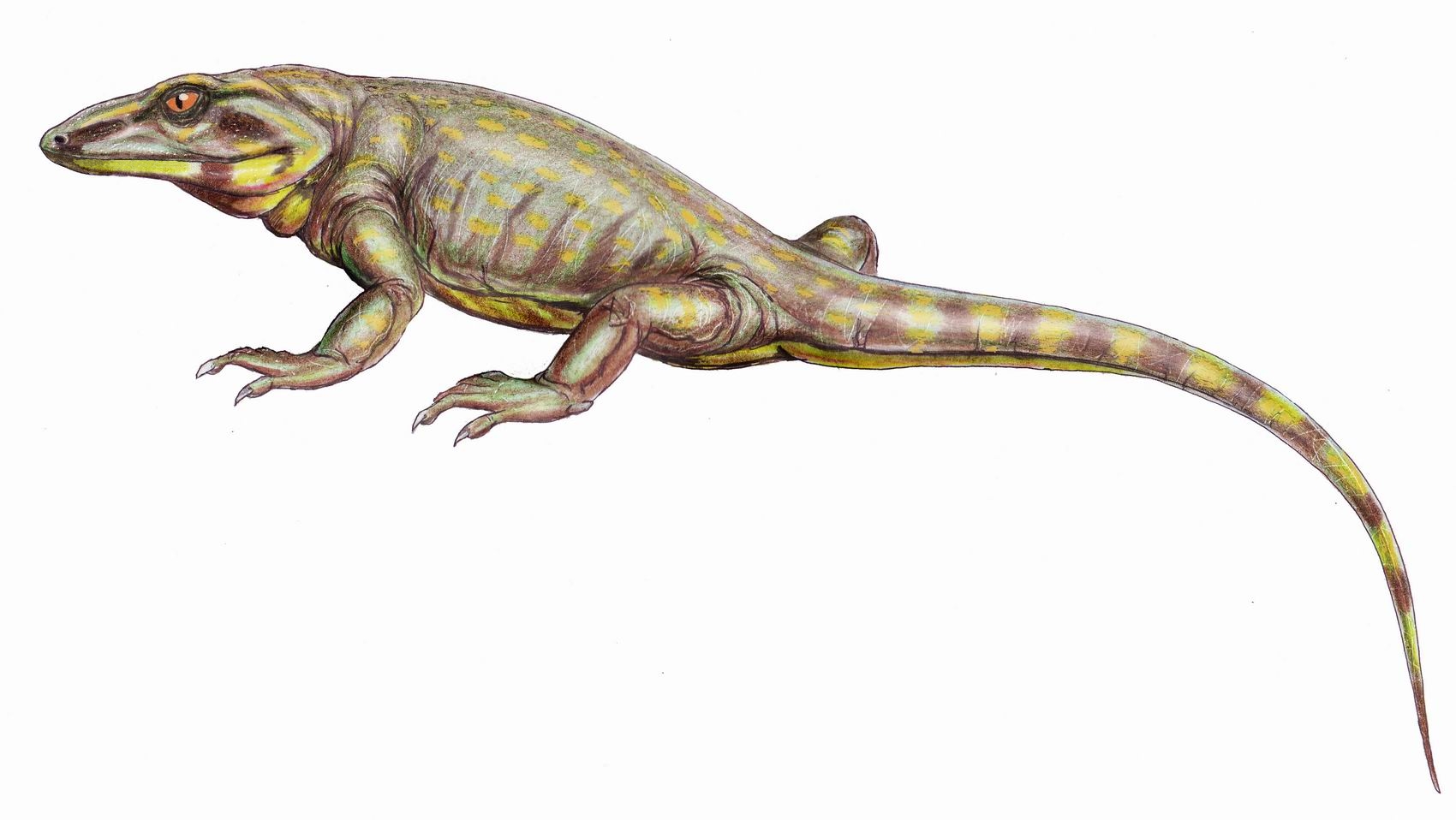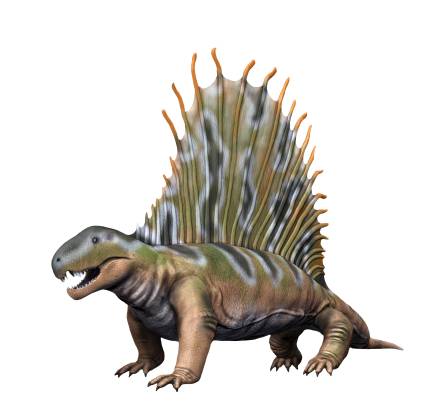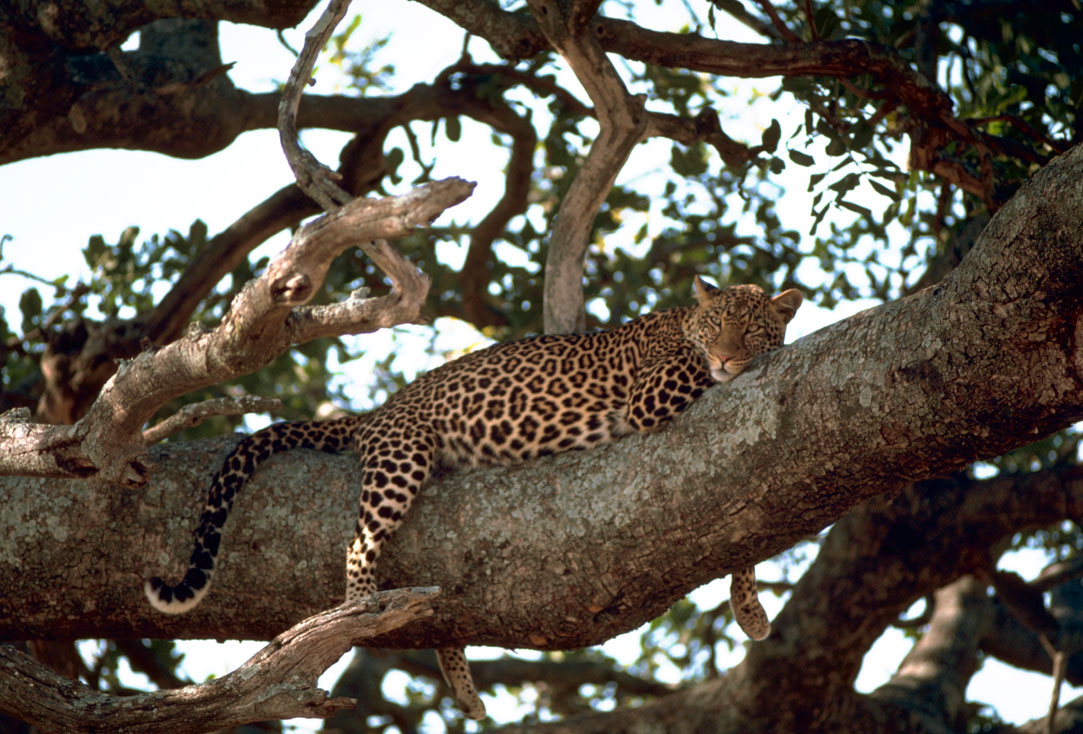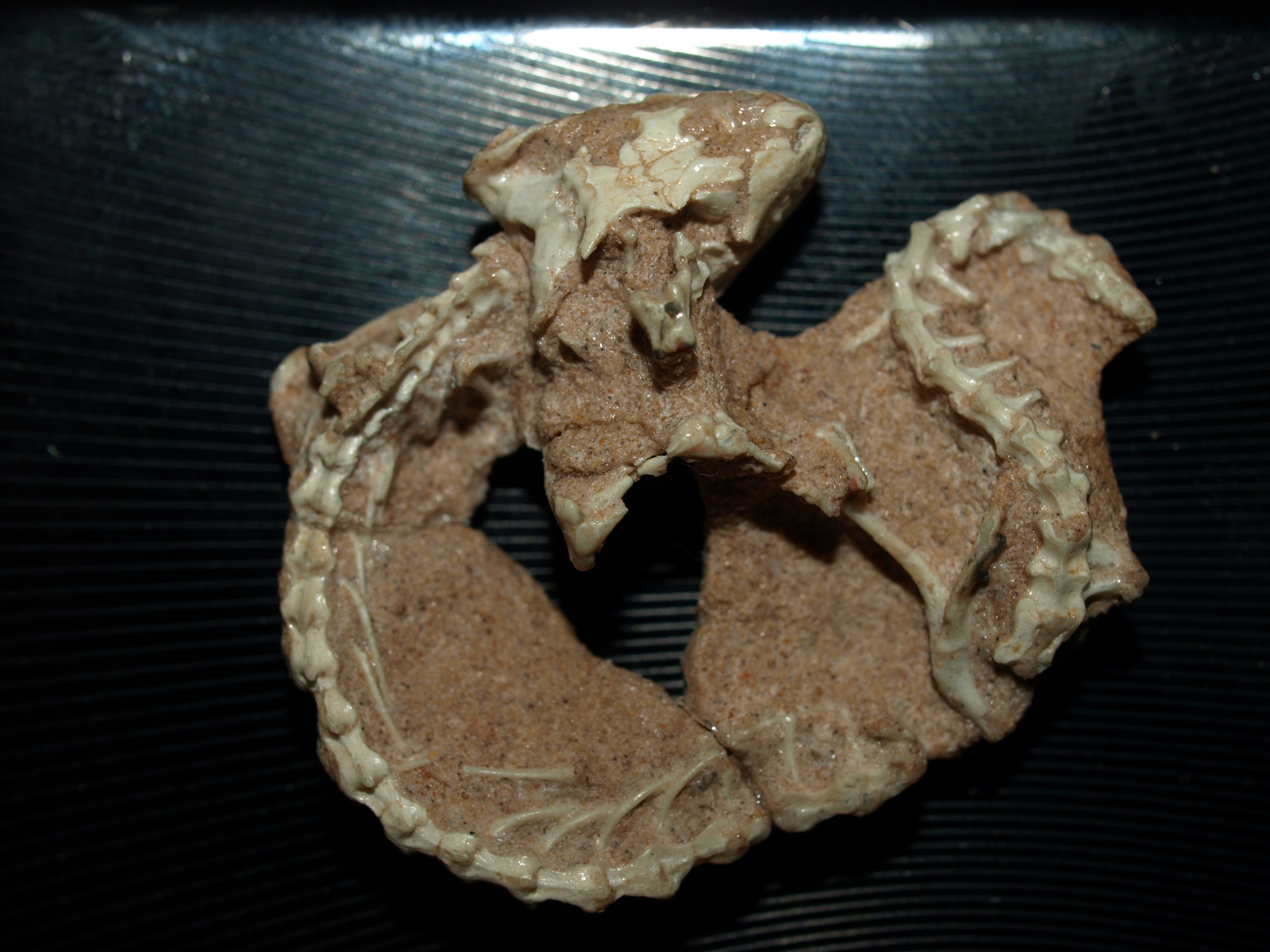|
Varanopids
Varanopidae is an extinct family of amniotes known from the Late Carboniferous to Middle Permian that resembled monitor lizards (with the name of the group deriving from the monitor lizard genus ''Varanus'') and may have filled a similar niche. Typically, they are considered to be relatively basal synapsids (and thus more closely related to mammals than to reptiles), although some studies from the late 2010s recovered them being taxonomically closer to diapsid reptiles, recent studies from the early 2020s support their traditional placement as synapsids on the basis of high degree of bone labyrinth ossification, maxillary canal morphology and phylogenetic analyses. A varanopid from the late Middle Permian ''Pristerognathus'' Assemblage Zone (Capitanian) is the youngest known varanopid and the last member of the "pelycosaur" group of synapsids. Thus, Varanopidae vanishes from the fossil record at the same time as dinocephalians, plausibly as a result of a major mass extinction eve ... [...More Info...] [...Related Items...] OR: [Wikipedia] [Google] [Baidu] |
Heleosaurus
''Heleosaurus scholtzi'' is an extinct species of basal synapsids, known as pelycosaurs, in the family of Varanopidae during the middle Permian.Reisz, R. R. & Modesto, S. P. 2007. ''Heleosaurus scholtzi'' from the Permian of South Africa: a varanopid synapsid, not a diapsid reptile. ''Journal of Vertebrate Paleontology'' 27 (3): 734-739. At first ''H. scholtzi'' was mistakenly classified as a diapsid. Members of this family were carnivorous and had dermal armor, and somewhat resembled monitor lizards. This family was the most geologically long lived, widespread, and diverse group of early amniotes. To date only two fossils have been found in the rocks of South Africa.Broom, R. "On Some New Fossil Reptiles from the Karroo Beds of Victoria West, South Africa." ''Transactions of the South African Philosophical Society'' 18 (1907): 31-42. Taylor and Francis Online. Web. Botha-Brink, Jennifer. "A Mixed-Age Classed 'Pelycosaur' Aggregation from South Africa: Earliest Evidence of Parental ... [...More Info...] [...Related Items...] OR: [Wikipedia] [Google] [Baidu] |
Varanopidae
Varanopidae is an extinct family (biology), family of amniotes known from the Late Carboniferous to Middle Permian that resembled monitor lizards (with the name of the group deriving from the monitor lizard genus ''Varanus'') and may have filled a similar niche. Typically, they are considered to be relatively Basal (phylogenetics), basal Synapsida, synapsids (and thus more closely related to mammals than to reptiles), although some studies from the late 2010s recovered them being taxonomically closer to diapsid reptiles, recent studies from the early 2020s support their traditional placement as synapsids on the basis of high degree of bone labyrinth ossification, maxillary canal morphology and phylogenetic analyses. A varanopid from the late Middle Permian Pristerognathus Assemblage Zone, ''Pristerognathus'' Assemblage Zone (Capitanian) is the youngest known varanopid and the last member of the "pelycosaur" group of synapsids. Thus, Varanopidae vanishes from the fossil record at th ... [...More Info...] [...Related Items...] OR: [Wikipedia] [Google] [Baidu] |
Late Carboniferous
Late or LATE may refer to: Everyday usage * Tardy, or late, not being on time * Late (or the late) may refer to a person who is dead Music * Late (The 77s album), ''Late'' (The 77s album), 2000 * Late (Alvin Batiste album), 1993 * Late!, a pseudonym used by Dave Grohl on his ''Pocketwatch (album), Pocketwatch'' album * Late (rapper), an underground rapper from Wolverhampton * "Late", a song by Kanye West from ''Late Registration'' Other uses * Late (Tonga), an uninhabited volcanic island southwest of Vavau in the kingdom of Tonga * Late (The Handmaid's Tale), "Late" (''The Handmaid's Tale''), a television episode * LaTe, Laivateollisuus, Oy Laivateollisuus Ab, a defunct shipbuilding company * Limbic-predominant age-related TDP-43 encephalopathy, a proposed form of dementia * Local-authority trading enterprise, a New Zealand business law * Local average treatment effect, a concept in econometrics * Late, a synonym for ''cooler'' in Stellar classification#"Early" and "late" nomencla ... [...More Info...] [...Related Items...] OR: [Wikipedia] [Google] [Baidu] |
Dimetrodon
''Dimetrodon'' ( or ; ) is an extinct genus of sphenacodontid synapsid that lived during the Cisuralian (Early Permian) Epoch (geology), epoch of the Permian period, around 295–272 million years ago. With most species measuring long and weighing , the most prominent feature of ''Dimetrodon'' is the large neural spine sail on its back formed by elongated spines extending from the vertebrae. It was an obligate Quadrupedalism, quadruped (it could walk only on four legs) and had a tall, curved skull with large teeth of different sizes set along the jaws. Most fossils have been found in the Southwestern United States, the majority of these coming from a geological deposit called the Red Beds of Texas and Oklahoma. More recently, its fossils have also been found in Germany and over a dozen species have been named since the genus was first erected in 1878. ''Dimetrodon'' is often mistaken for a dinosaur or portrayed as a contemporary of dinosaurs in popular culture, but it beca ... [...More Info...] [...Related Items...] OR: [Wikipedia] [Google] [Baidu] |
Arboreal Locomotion
Arboreal locomotion is the animal locomotion, locomotion of animals in trees. In habitats in which trees are present, animals have evolution, evolved to move in them. Some animals may scale trees only occasionally (scansorial), but others are exclusively arboreal. The habitats pose numerous mechanical challenges to animals moving through them and lead to a variety of anatomical, behavioral and ecological consequences as well as variations throughout different species.Matt Cartmill, Cartmill, M. (1985). "Climbing". pp. 73–88 ''In'': Hildebrand, Milton; Bramble, Dennis M.; species:Karel Frederik Liem, Liem, Karel F.; David B. Wake, Wake, David B. (editors) (1985). ''Functional Vertebrate Morphology''. Cambridge, Massachusetts: Harvard University Press, Belknap Press. 544 pp. . Furthermore, many of these same principles may be applied to climbing without trees, such as on rock piles or mountains. Some animals are exclusively arboreal in habitat, such as tree snails. Biomechanic ... [...More Info...] [...Related Items...] OR: [Wikipedia] [Google] [Baidu] |
Eoscansor
''Eoscansor'' (EE-oh-SKAN-sor; meaning "dawn climber") is a species of small varanopid amniote that lives from the upper Pennsylvanian subperiod in northern New Mexico, United States 305 million years ago. The species ''Eoscansor cobrensis'' was 24.5 centimeters (9.6 inches) long and weighed 58.3 grams. The tetrapods teeth indicated that it was insectivorous. The small size and grasping limbs means that was ''E. cobrensis'' highly agile and likely arboreal (tree climbing). The name ''Eoscansor'' means "dawn climber", derived from Greek "Eos" meaning dawn and Latin "scansor" meaning climber. ''E. cobrensis'' is currently the oldest specialised climbing tetrapod animal pushing back the original record by 15 million years. The species was discovered in the El Cobre Canyon Formation in northern New Mexico near the village of Chama in 2005 but was not prepared until 2015. The COVID-19 pandemic in 2020 pushed study back until 2022 where it was described as a new genus and species. '' ... [...More Info...] [...Related Items...] OR: [Wikipedia] [Google] [Baidu] |
Pangea
Pangaea or Pangea ( ) was a supercontinent that existed during the late Paleozoic and early Mesozoic eras. It assembled from the earlier continental units of Gondwana, Euramerica and Siberia (continent), Siberia during the Carboniferous period approximately 335 million years ago, and began to break apart about 200 million years ago, at the end of the Triassic–Jurassic extinction event, Triassic and beginning of the Jurassic. Pangaea was C-shaped, with the bulk of its mass stretching between Earth's northern and southern polar regions and surrounded by the superocean Panthalassa and the Paleo-Tethys Ocean, Paleo-Tethys and subsequent Tethys Oceans. Pangaea is the most recent supercontinent to have existed and was the first to be reconstructed by geologists. Origin of the concept The name "Pangaea" is derived from Ancient Greek ''pan'' (, "all, entire, whole") and ''Gaia (mythology), Gaia'' or Gaea (, "Mother goddess, Mother Earth, land"). The first to suggest that the con ... [...More Info...] [...Related Items...] OR: [Wikipedia] [Google] [Baidu] |
Squamates
Squamata (, Latin ''squamatus'', 'scaly, having scales') is the largest order of reptiles; most members of which are commonly known as lizards, with the group also including snakes. With over 11,991 species, it is also the second-largest order of extant (living) vertebrates, after the perciform fish. Squamates are distinguished by their skins, which bear horny scales or shields, and must periodically engage in molting. They also possess movable quadrate bones, making possible movement of the upper jaw relative to the neurocranium. This is particularly visible in snakes, which are able to open their mouths very widely to accommodate comparatively large prey. Squamates are the most variably sized living reptiles, ranging from the dwarf gecko (''Sphaerodactylus ariasae'') to the reticulated python (''Malayopython reticulatus''). The now-extinct mosasaurs reached lengths over . Among other reptiles, squamates are most closely related to the tuatara, the last surviving member of ... [...More Info...] [...Related Items...] OR: [Wikipedia] [Google] [Baidu] |
Ascendonanus
''Ascendonanus'' (meaning "climbing dwarf") is an extinct genus of varanopid amniote from the Early Permian of Germany. It is one of the earliest specialized arboreal (tree-living) tetrapods currently known and outwardly resembled a small lizard. The animal was about 40 cm long, with strongly curved claws, short limbs, a slender, elongated trunk, and a long tail. It would have preyed on insects and other small arthropods. The taxonomic position of varanopids is currently debated between synapsids (related to mammals, the most widely accepted idea) and diapsids (related to reptiles). The fossils of ''Ascendonanus'' are of special scientific importance because they include remains of skin, scales, scutes, bony ossicles, and soft-tissue body outlines, which could indicate that some of the oldest relatives of mammals had a scaly "reptilian-type" appearance. The related small varanopid '' Eoscansor'', recently described from New Mexico, was also adapted to climbing, very likely i ... [...More Info...] [...Related Items...] OR: [Wikipedia] [Google] [Baidu] |
Mesenosaurus And Varanodon
''Mesenosaurus'' is an extinct genus of synapsid belonging to the family Varanopidae. This genus includes two species: the type species ''Mesenosaurus romeri'' from the middle Permian (upper Kazanian) Mezen River Basin of northern Russia, and ''Mesenosaurus efremovi'' from the early Permian (Artinskian) Richards Spur locality (Oklahoma, United States). ''M. romeri''’s stratigraphic range is the middle to late Guadalupian while ''M. efremovi''’s stratigraphic range is the Cisuralian. Etymology Famous Russian paleontologist, Ivan Efremov, established ''Mesenosaurus'' as a genus. The genus name means “lizard from Mezen” while the specific epithet is given in honor of Alfred Romer. ''Mesenosaurus efremovi'' was named in honor of Ivan Efremov, who erected the genus. Description ''Mesenosaurus'' are small sized varanopid synapsids. They are characterized by mainly cranial features. Many of the postcranial features of this genus have not been analyzed fully due to a lack ... [...More Info...] [...Related Items...] OR: [Wikipedia] [Google] [Baidu] |
Early Permian
01 or 01 may refer to: * The year 2001, or any year ending with 01 * The month of January * 1 (number) Music * '01 (Richard Müller album), ''01'' (Richard Müller album), 2001 * 01 (Urban Zakapa album), ''01'' (Urban Zakapa album), 2011 * ''01011001'', the seventh studio album from Arjen Anthony Lucassen's Ayreon project Other uses * 01 (telephone number), United Kingdom internal dialing code for London between the late 1950s and 1990 * Lynk & Co 01, a compact SUV built since 2017 * Nammi 01, an electric subcompact hatchback * Ji Yue 01, an electric crossover SUV * BAR 01, a Formula One car * Zero One also known as ''Machine City'', a city-state from the ''The Matrix (series), Matrix'' series * Kolmogorov's zero-one law, a law of probability theory * Pro Wrestling ZERO1-MAX, a wrestling promotion formerly known as Pro Wrestling ZERO-ONE * The number of the French department Ain * The codename given to the Wing Gundam by Oz in the anime ''Gundam Wing'' * ''Kamen Rider Zero-One'', ... [...More Info...] [...Related Items...] OR: [Wikipedia] [Google] [Baidu] |







